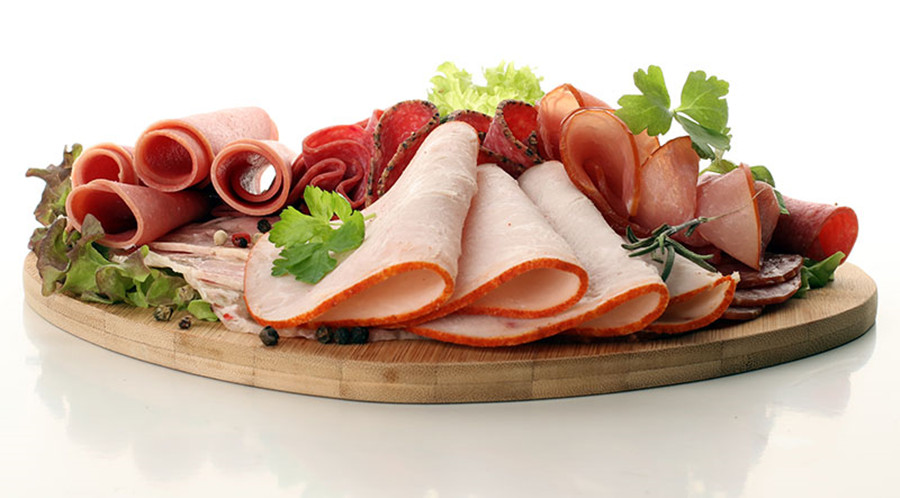At present, the total output of high-temperature ham sausage in China has accounted for 1/3 of all meat products. Its automatic production, convenient and fast, hygienic and nutritious, and long shelf-life make it all over the country.
As the market share continues to increase, the problems found are also increasing. There are corresponding research topics for its texture characteristics in different periods and the problems that will occur during storage.
The purpose of this study was to explore the factors affecting the quality of high-temperature ham sausage and the reasons for oil production and swelling. By measuring product texture, water holding capacity, color, flavor, and other indicators, the effects of cooking temperature and storage temperature of raw meat on quality were studied.
1. Materials and Methods
1.1. Main Experimental Materials
Raw pork (Dennis All Nippon Fresh), collagen casings (De Fulong Biotechnology Co., Ltd.).
1.2. Main Instruments and Equipment
MM12B meat grinder, VF608Plus vacuum sausage filler machine, BLKJ-20 mixer, electronic nose(air sense analytics), TA-XT puls physical property analyzer (Texture Analyser), color difference meter (CHROMA METER).
1.3. Experiment Method
1.3.1. Production of High-Temperature Ham Sausage
Raw Meat Storage → Thawing and Dressing → Salting for 6 Hours → Chopping (the 30s at high speed, 30s at low speed, 1min at high speed) → Filling → after cooking, put it in a constant temperature blast dryer for 1 hour to cook and sterilize to simulate the temperature of the sterilization kettle.
1.3.2. Effects of Different Temperature Treatments on the Quality of High-temperature Ham Sausage
Raw meat was stored at -40℃, -24℃ and 4℃ to explore its influence on product quality.
Cooking temperature (90 ℃, 100 ℃, 110 ℃, 120 ℃), to explore its influence on product quality.
1.3.3. Indicator Determination
A. Determination of Texture
Sample pretreatment: After peeling off the casing, it was cut into a cylinder with a length of 2 cm, and the Tpa experiment was carried out.
Experimental conditions: P50 probe, the pre-measurement speed is 2mm/s, the mid-measurement speed is 5mm/s, the post-measurement speed is 10mm/s, and the compression ratio is 40%. An average of 6 experiments are performed for each test condition, and the results are averaged.
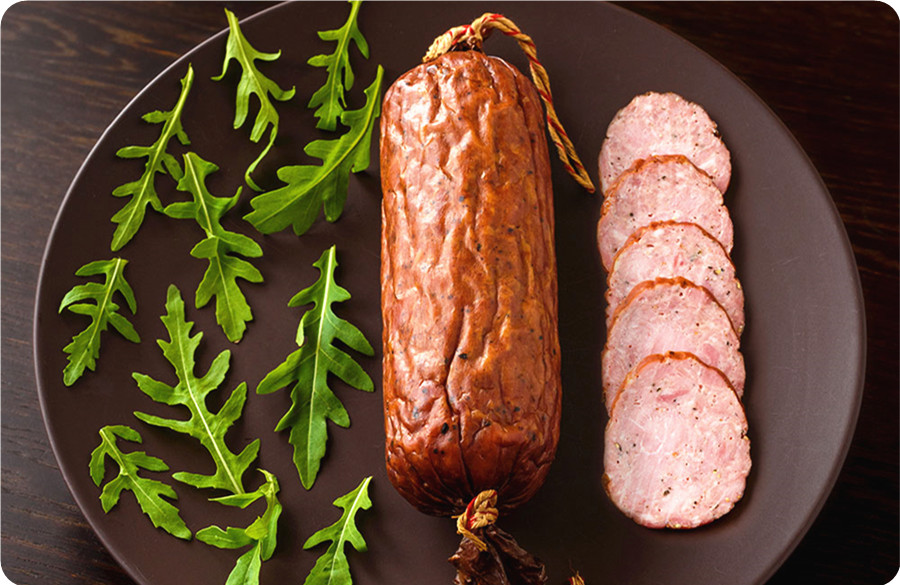
Use Excel to plot the texture range of hardness, elasticity, chewiness, cohesion, adhesiveness, and recovery, and then use spss16.0 software for analysis.
B. Determination of Color Difference
The color of the ham was measured by a colorimeter, and the average value was taken for 6 measurements. The color data were uniformly expressed in the L*, a*, b* color spaces. The sample was pretreated, and after peeling the casing, it was cut into a cylinder with a length of 2 cm, and the color difference was measured. Experimental conditions: wrap the colorimeter with a protective film, and set the flash to directly output the value once.
C. Determination of Electronic Nose
Sample pretreatment: After peeling off the casing, cut it into small pieces and put it into a conical flask, 10g of sample per bottle, seal it with plastic wrap three times, and then tighten the bottle mouth with a rubber band. The constant temperature water bath was set to 40°C, and the measurement was carried out after 5 minutes of water bath. Each measurement condition was carried out on average for 3 experiments, and then the electronic nose was used to analyze and obtain the results.
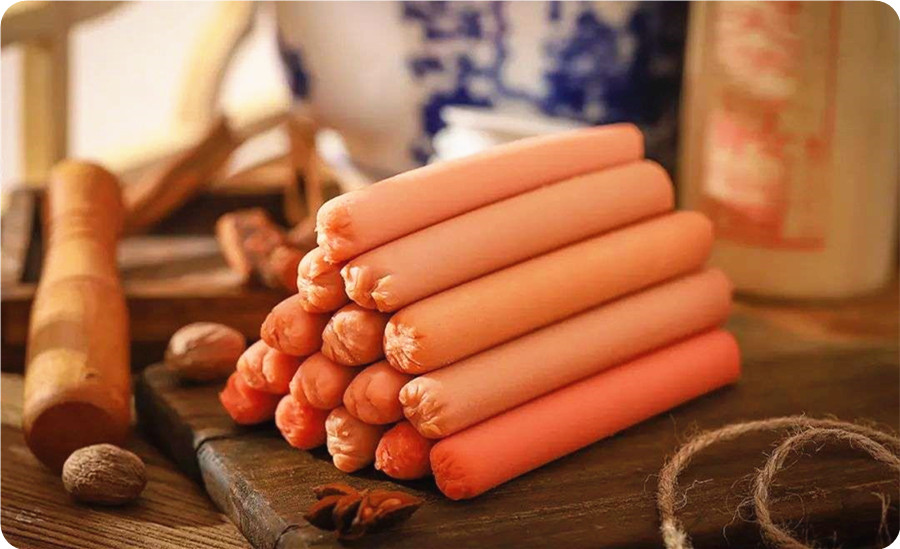
D. Determination of Water Holding Capacity
Sample pretreatment, after peeling off the casing, cut it into appropriate size, weigh it as the sample weight before centrifugation, wrap it with absorbent paper, put it into a measuring tube, and then balance it, put it into the centrifuge after balancing, and set the speed to 4 000r/s, after centrifugation for 1 h, the sample was taken out and weighed to obtain the sample weight after centrifugation. Three experiments were performed on average for each measurement condition, and the results were averaged.
According to the formula: water holding capacity=(sample weight before centrifugation-sample weight after centrifugation)/sample weight after centrifugation. Get water holding capacity.
E. Determination of Oil out and Bag Swelling Time
The prepared samples were cooled to room temperature and stored at 4°C, and the storage time was recorded. Observe whether there is oil leakage and bag swelling every day, and record the time to calculate how many hours each sample will have oil leakage and bag swelling. By observing the appearance time of oil droplets or oozing spots on the surface of the intestinal body, oil on the entire casing, greasy feeling and smell when touching the hand, the influence of processing temperature on the oil production of the product can be judged. The effect of processing temperature on the puffing phenomenon of the product was judged by observing the time of acid gas generated in the intestine and the gas generated between the intestine and the casing. Three parallel groups were set for each sample, and the interval hours between oil out and bag swelling were averaged.
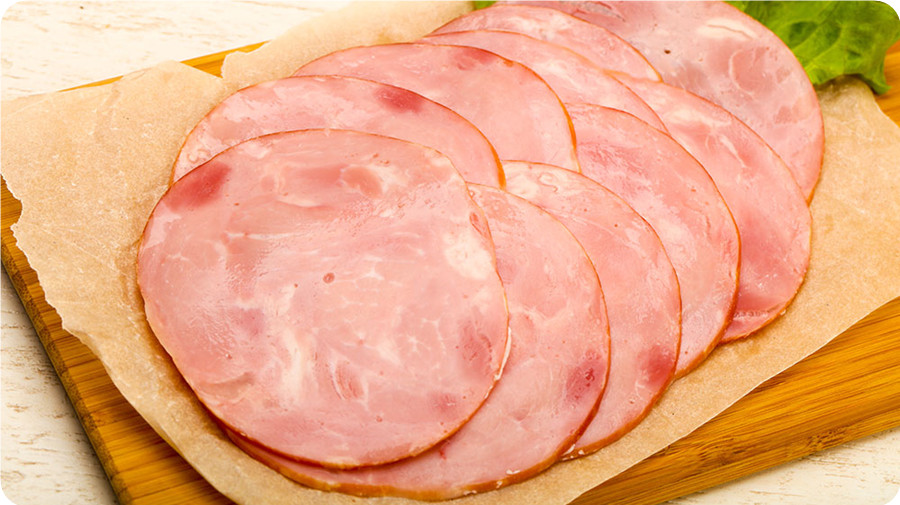
1.4. Data Processing
Using SPSS16.0 (SPSS company) to carry out a one-way analysis of variance on the measurement data of texture machinery and the measurement data of colorimeter.
2. Results and Analysis
2.1. Effect of Temperature on the Texture of High-temperature Ham Sausage
2.1.1. Effect of Cooking Temperature on Product Texture
It can be seen from Table 1 that the hardness and chewiness of high-temperature ham sausages increase with the increase in cooking temperature. Elasticity, on the other hand, remained stable overall. It shows that the cooking temperature significantly affects the hardness and chewiness of the product.
| 4℃ Group | Hardness/g | Elasticity | Chewy/g |
| 90℃ | 137.71±79.51a | 0.82±0.03a | 691.35±100.76a |
| 100℃ | 272.34±157.24a | 0.87±0.02a | 1195.50±242.78a |
| 110℃ | 602.60±347.91b | 0.91±0.01a | 3630.60±526.53bc |
| 120℃ | 3021.64±2136.62ab | 0.95±0.05a | 3255.80±1738.02c |
Note: The data in the table are “mean ± standard deviation”. Data in the same column without the same letter at the tail indicated a significant difference (p<0.05).
| 4℃ Group | Cohesion | Adhesion/g | Recoverability |
| 90℃ | 0.76±0.01a | 839.90±96.67ab | 0.35±0.02a |
| 100℃ | 0.77±0.01a | 1372.90±259.37b | 0.36±0.01a |
| 110℃ | 0.74±0.03a | 3981.60±572.98a | 0.39±0.03a |
| 120℃ | 0.75±0.02a | 4063.90±786.38ab | 0.40±0.03a |
Note: The data in the table are “mean ± standard deviation”. Data in the same column without the same letter at the tail indicated a significant difference (p<0.05).
It can be seen from Table 2 that the adhesiveness of high-temperature ham sausage increases with the increase of cooking temperature and reaches the maximum at 120 °C. While cohesion and resilience remained stable overall. It shows that the cooking temperature significantly affects the adhesiveness of the product.
From the analysis of Table 1 and Table 2, it can be seen that the higher the cooking temperature, the greater the hardness, chewiness, and stickiness of the product, and when the cooking temperature reaches 120°C, the product has higher hardness, chewiness, and stickiness. However, elasticity, cohesion, and recovery remained stable with increasing cooking temperature.
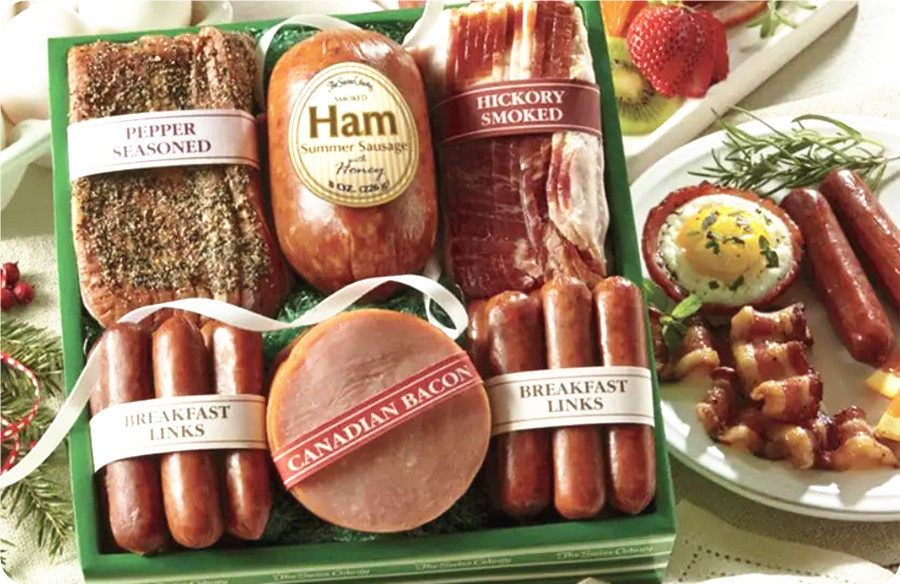
2.1.2 Effect of Storage Temperature of Raw Meat on Product Texture
It can be seen from Table 3 that the chewiness of the high-temperature ham sausage decreases with the decrease of the storage temperature of the raw meat, and reaches the minimum at -40°C, while the elasticity remains stable as a whole. The change of hardness is more complicated, when the storage temperature is 4°C, it has a maximum value, and when the storage temperature is -24°C, it has a minimum value. However, the hardness at -24°C was not significantly different from the hardness at -40°C. (p<0.05) indicates that the storage temperature of raw meat significantly affects the hardness and chewiness of the product.
| 110℃ Group | Hardness/g | Elasticity | Chewy |
| 4℃ | 5371.20±602.60a | 0.91±0.01a | 3630.60±526.53a |
| -24℃ | 3105.20±1586.70b | 0.91±0.02a | 2827.50±23.32ab |
| -40℃ | 3904.00±651.06ab | 0.87±0.05a | 2579.00±487.12b |
Note: The data in the table are “mean ± standard deviation”. Data in the same column without the same letter at the tail indicated a significant difference (p<0.05).
It can be seen from Table 4 that the adhesiveness of the high-temperature ham sausage decreases with the decrease of the storage temperature of the raw meat, and reaches the minimum at -40 °C, while the cohesion and recovery remain stable as a whole. It shows that the storage temperature of raw meat significantly affects the adhesiveness of the product.
| 110℃ Group | Cohesion | Adhesion/g | Recoverability |
| 4℃ | 0.74±0.03a | 3981.60±572.98a | 0.39±0.03a |
| -24℃ | 0.76±0.01a | 3031.20±69.67b | 0.41±0.01a |
| -40℃ | 0.76±0.02a | 2969.70±494.73b | 0.39±0.02a |
Note: The data in the table are “mean ± standard deviation”; data in the same column without the same letter at the tail indicates a significant difference (p<0.05).
According to the analysis in Table 3 and Table 4, the higher the storage temperature of raw meat, the greater the hardness, chewability, and adhesion of the product. When the storage temperature of raw meat is 4 ℃, the product has higher hardness, chewability, and adhesion. However, the elasticity, cohesion, and recovery of raw meat remained stable with the increase in storage temperature
2.2. The effect of temperature on the color of high-temperature ham sausage
2.2.1. The effect of cooking temperature on product color
It can be seen from Table 5 that the a* and b* values in the color difference data of high-temperature ham sausage decrease with the increase of the cooking temperature, and reach the minimum when the cooking temperature is 120°C. The L* value remained stable overall. It shows that the cooking temperature significantly affects the a* value and b* value of the product color difference.
| 4℃ Group | L* | a* | b* |
| 90℃ | 68.81±0.92a | 0.59±0.43a | 13.22±0.68a |
| 100℃ | 71.07±2.14a | 0.39±0.03ab | 12.25±0.08ab |
| 110℃ | 70.34±2.76a | -0.15±0.42b | 11.26±0.36b |
| 120℃ | 69.15±0.40a | -0.23±0.38b | 11.17±0.52b |
Note: The data in the table are “mean ± standard deviation”. Data in the same column without the same letter at the tail indicated a significant difference (p<0.05).
2.2.2. Influence of raw meat storage temperature on product color
It can be seen from Table 6 that the a* value in the color difference data of high-temperature ham sausage increases with the decrease of the storage temperature of the raw meat, and the storage temperature of the raw meat increases.
| 4110℃ Group | L* | a* | b* |
| 90℃ | 71.14±1.35a | -0.63±0.13a | 11.42±0.60a |
| -24℃ | 69.92±1.55a | -0.46±0.09a | 11.52±1.01a |
| -40℃ | 71.14±2.05a | -0.22±0.05b | 11.86±0.88a |
Note: The data in the table are “mean ± standard deviation”. Data in the same column without the same letter at the tail indicated a significant difference (p<0.05).
The maximum temperature is reached at -40°C. The b* and L* values remained stable overall. It shows that the storage temperature of raw meat significantly affects the a* value in the color difference of the product.
From the analysis of Table 5 and Table 6, it can be seen that the higher the cooking temperature, the smaller the a* and b* values in the product color difference data, indicating that the red and yellow in the product color are less obvious. The lower the storage temperature of raw meat, the greater the a* value in the product color difference data, indicating that the red color in the product is more obvious.
2.3. The Effect of Temperature on the Flavor of High-temperature Ham Sausage
2.3.1. The effect of cooking temperature on product flavor
It can be seen from Figure 1 that the PCA of the electronic nose with volatile odor: the contribution rate of the first principal component is 98.57%, the contribution rate of the second principal component is 1.34%, and the total contribution rate is 99.91%.
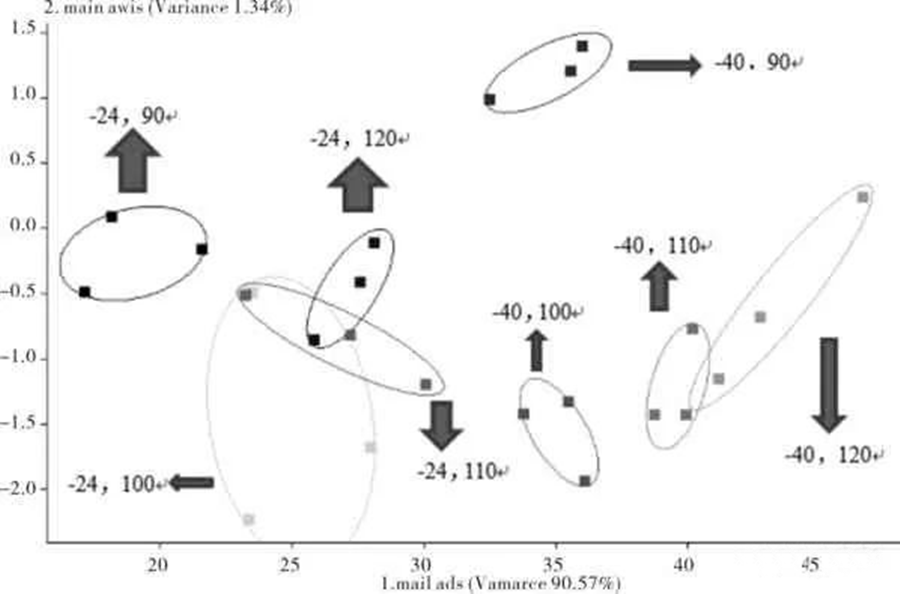
The larger the contribution rate, the better the odor components of the ham can be distinguished. Figure 1 shows that the change in the volatile smell of ham with the cooking temperature is very obvious. When the storage temperature of raw meat was -24°C, and the cooking temperature was 100°C, 110°C, and 120°C, the volatile odor analysis of the electronic nose was relatively close, and there was no significant difference. When the cooking temperature is 90°C, it is far from the volatile odor analysis of the electronic nose with the cooking temperature of 100°C, 110°C, and 120°C, and there is a significant difference. When the storage temperature of the raw meat is -40°C and the cooking temperature is 110°C and 120°C, the volatile odor analysis of the electronic nose is relatively close, and there is no significant difference; when the cooking temperature is 90°C and 100°C, there is The volatile odor analysis of the electronic nose with the cooking temperature of 110 ℃ and 120 ℃ is farther, and there is a significant difference. Therefore, as the cooking temperature increased, the closer the electronic nose volatile odor analysis was, the less significant the difference was.
2.3.2. Influence of raw meat storage temperature on product flavor
It can be seen from Figure 2 that the PCA of the electronic nose with volatile odor: the contribution rate of the first principal component is 98.44%, the contribution rate of the second principal component is 1.48%, and the total contribution rate is 99.92%.

The larger the contribution rate, the better the odor components of the ham can be distinguished. Fig. 2 shows that the change in the volatile smell of sausage with the storage temperature of raw meat is very obvious. When the cooking temperature is 120°C, and the raw meat storage temperature is 4°C, -24°C, and -40°C, the volatile odor analysis of the electronic nose is far away, and there are significant differences; when the cooking temperature is 90°C, the raw meat When the storage temperature is 4°C, -24°C, and -40°C, the volatile odor analysis of the electronic nose is relatively far. Although the volatile odor analysis of the electronic nose at the storage temperature of -40°C and 4°C is closer but the overlap is less, but It may be caused by the different storage times of the samples. The samples at -40°C and 4°C have the same storage time during the test, but the -24°C sample has a shorter storage time due to its relatively late production, which leads to this phenomenon. Therefore, there were significant differences in the electronic nose analysis results between the storage temperatures of different raw meats. Therefore, the storage temperature of raw meat will affect the flavor of the product.
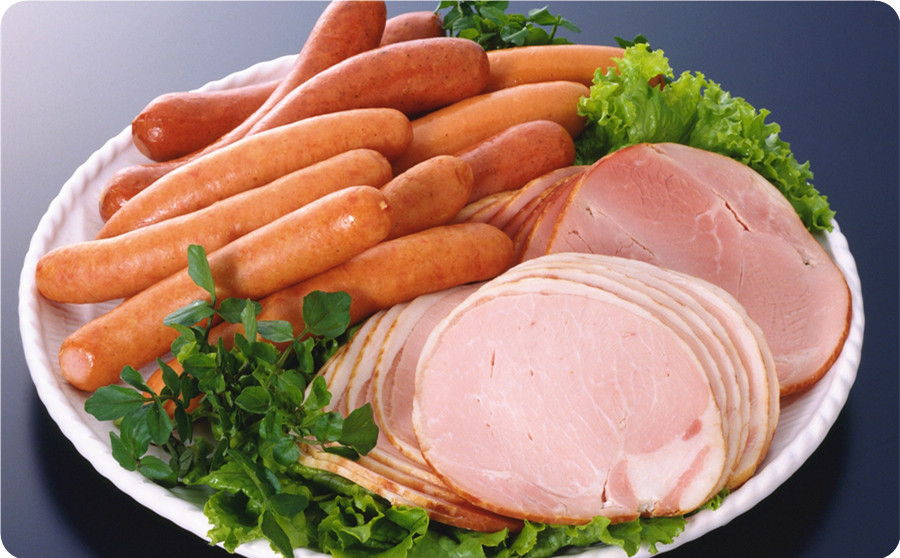
2.4. Effect of Temperature on Water Retention of High-temperature Ham Sausage
2.4.1. Influence of Cooking Temperature on Water Retention of Products
It can be seen from Figure 3 that the effect of cooking temperature on the water holding capacity of high-temperature ham sausage is more complicated. When the cooking temperature is 100 °C, the value of water holding capacity is the largest, and the water holding capacity of the product is the worst at this time.
When the cooking temperature is 110℃, the water holding capacity is the smallest, and the water holding capacity of the product is the best at this time. And when the cooking temperature was raised to 120°C, the water retention of the product became slightly weaker. It shows that the water retention of high-temperature ham sausage reaches the best when the cooking temperature is 110℃.

2.4.2. Influence of Raw Meat Storage Temperature on Product Water Retention
It can be seen from Figure 4 that the water holding capacity of the high-temperature ham sausage will change with the decrease in the storage temperature of the raw meat. When the storage temperature of the raw meat is -40 ℃, the water holding capacity of the product reaches the highest.

Because the storage temperature of raw meat is low, the meat has better water-locking ability during storage. And it can be seen that the products cooked at 110 °C and 120 °C will have better water holding capacity even when the storage temperature is 4 °C, which may be because the meat is fresher, the water holding capacity is stronger, and the cooking temperature is higher. High makes the meat firmer.
It can be seen from Figure 3 and Figure 4 that both the cooking temperature and the raw meat cooking temperature will affect the water retention of the product. When the cooking temperature is 110 °C and the raw meat storage temperature is -40 °C, the product has the best water retention performance.
2.5. Influence of Temperature on Oil Production and Swelling of High-temperature Ham Sausage
2.5.1. Influence of Cooking Temperature on Product Oil and Bag Swelling
It can be seen from Figure 5 that with the increase of the cooking temperature, the time for the occurrence of oil out of the product is also pushed back, and under the condition of the cooking temperature of 120 °C, the time of oil out is the latest, about 92 hours later. The phenomenon of oil production occurs, which is about 40 hours later than that of the products cooked at 90 °C. It can be seen that the higher the cooking temperature of the product, the more beneficial it is to inhibit the oil production of the product, that is, to inhibit the occurrence of the phenomenon of small oil droplets flowing out of the intestinal body.
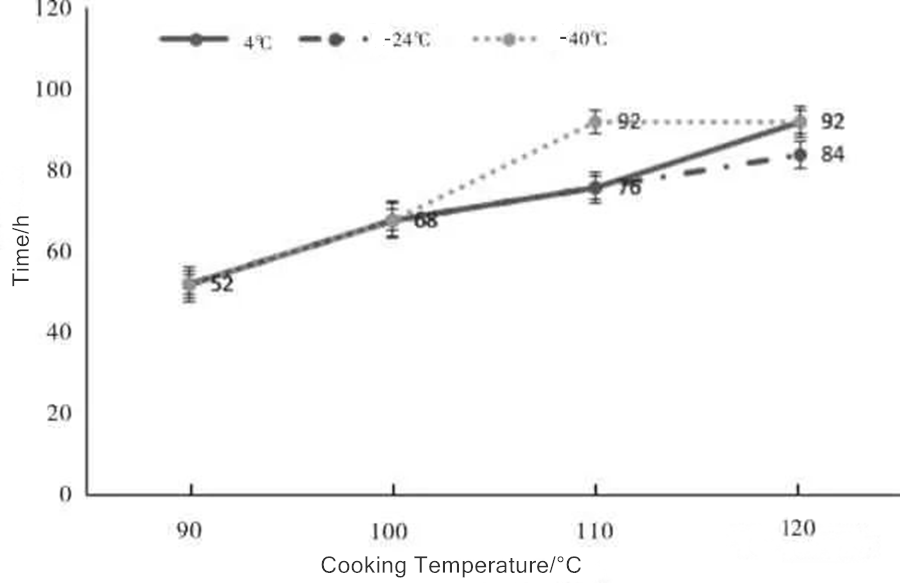
It can be seen from Figure 6 that the higher the cooking temperature, the later the bag swelling phenomenon occurs. Under the condition of cooking at 120 °C, the product will appear the bag swelling phenomenon after about 118 hours. Because with the increase of cooking temperature, the effect of sterilization is more obvious, and the occurrence of oil out and bag swelling can be suppressed more.

From the analysis of Fig. 5 and Fig. 6, it can be seen that as the cooking temperature increases, the products appear oily and puffed up later, indicating that a higher cooking temperature is conducive to inhibiting the occurrence of oily and puffy pouches in high-temperature ham sausages.
2.5.2. Influence of Raw Meat Storage Temperature on Product Oil Output and Bag Swelling
It can be seen from Figure 7 that when the cooking temperature is 110°C, as the storage temperature of the raw meat decreases, the time for the occurrence of oily products is later. However, in the case of other cooking temperatures, the storage temperature of raw meat did not have a significant effect on the oil yield of the product.
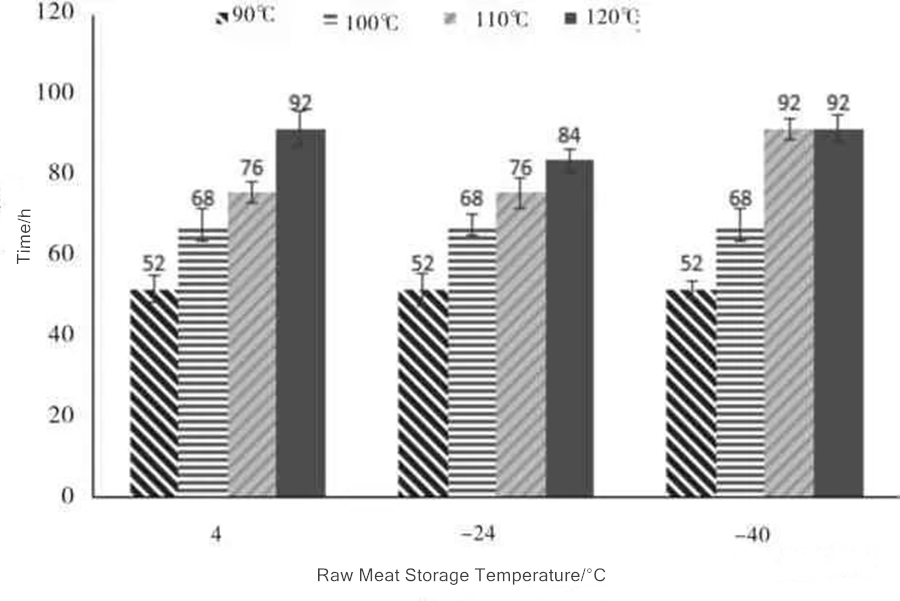
It can be seen from Figure 8 that with the decrease in the storage temperature of the raw meat, the time for the puffing phenomenon of the product is slightly pushed back. It shows that the lower the storage temperature of the raw meat, the later the time when the product appears to bulge, but the effect is not obvious.
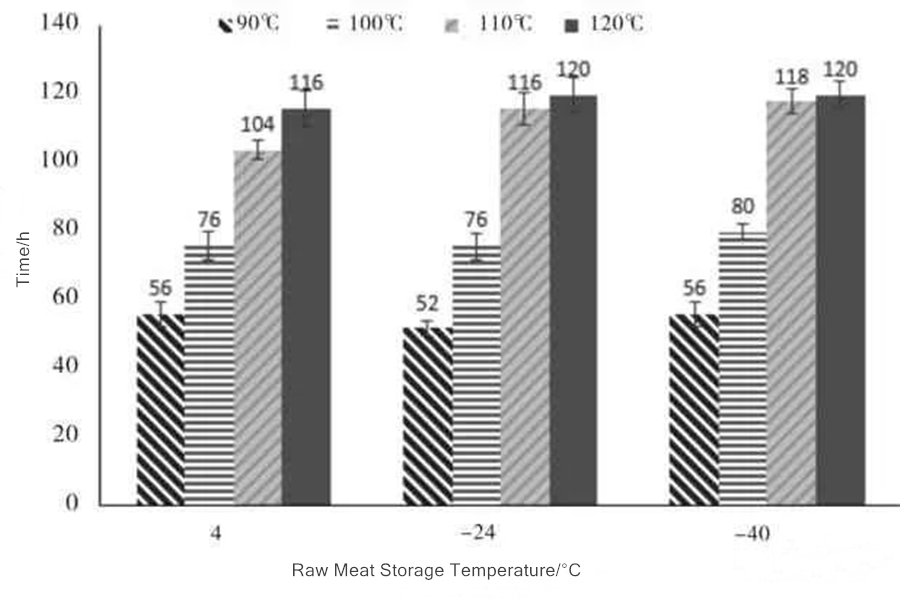
From the analysis of Fig. 7 and Fig. 8, it can be seen that the storage temperature of the raw meat will have a certain impact on the oil production and bag swelling of the product, which means that the lower the storage temperature of the raw meat, the more favorable it is to inhibit the oil production and the swelling of the product occur.
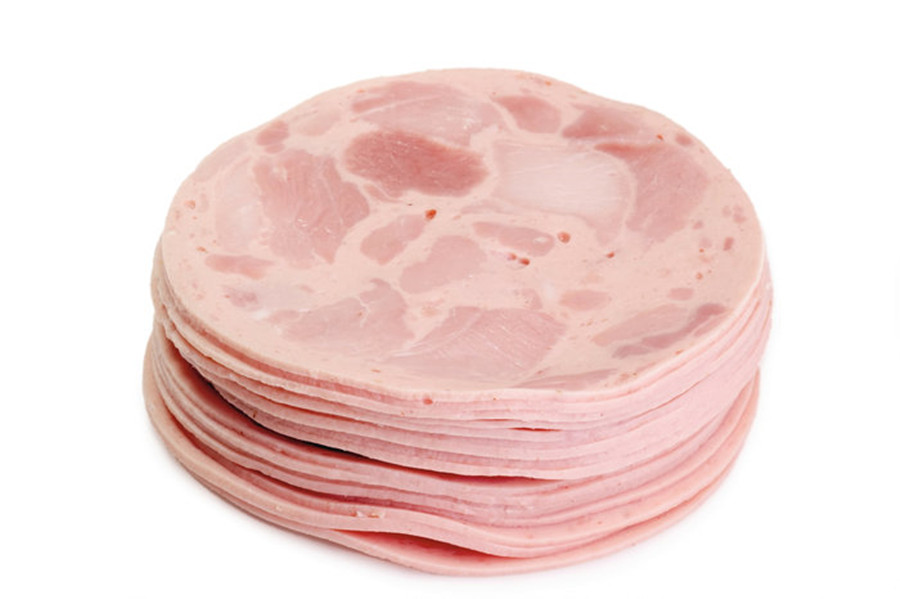
3. Conclusion
- The cooking temperature and raw meat storage temperature will have a significant impact on the hardness, chewability, and adhesion of high-temperature ham sausage. When the raw meat storage temperature is 4 ℃ and the cooking temperature is 120 ℃, the product has the maximum hardness, chewability, and adhesion.
- The higher the cooking temperature, the less noticeable the reds and yellows in the product color. The lower the storage temperature of raw meat, the more obvious the red color in the product.
- With the increase in cooking temperature, the difference in the flavor of high-temperature ham sausage is less significant. The storage temperature of raw meat has a significant effect on the flavor of high-temperature ham sausage.
- With the increase in the cooking temperature and the decrease in the storage temperature of the raw meat, the water retention of the high-temperature ham sausage changes irregularly. When the cooking temperature is 110 °C and the storage temperature of the raw meat is -40 °C, the product has the best water retention performance.
- The increase of the cooking temperature can effectively inhibit the oil out and bag swelling of the high-temperature ham sausage; the lowering of the storage temperature of the raw meat can slightly delay the time when the high-temperature ham sausage appears to oil and the swelling bag.

